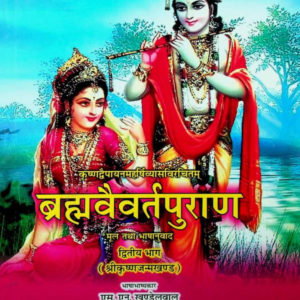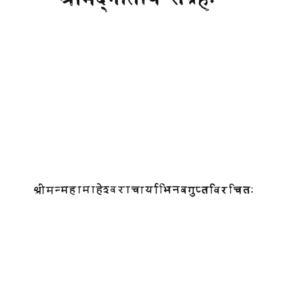Author: Abhinavgupt
About the Author:
Abhinavagupta was a seminal figure in Indian philosophy, mysticism, and aesthetics, best known for his contributions to the tradition of Kashmir Shaivism. Living between approximately 950 and 1016 CE, Abhinavagupta was a polymath whose works encompassed a wide range of subjects, including philosophy, theology, aesthetics, music, and poetry. His profound insights and systematic approach have left an enduring legacy in both the spiritual and intellectual landscapes of India.
Early Life and Background
Birth and Family:
- Abhinavagupta was born into a distinguished Brahmin family in Kashmir. His father, Narasimhagupta, and mother, Vimalakala, were both scholars and devotees, providing him with a rich intellectual and spiritual upbringing.
Education:
- Abhinavagupta was a prodigious student, excelling in a variety of disciplines. He studied under numerous teachers, mastering the Vedas, Agamas (Shaiva scriptures), Tantra, logic, grammar, and the arts. His education was deeply influenced by the non-dualistic (Advaita) teachings of Kashmir Shaivism.
Major Works and Contributions
Tantrāloka:
- Overview: The Tantrāloka (“Light on the Tantras”) is Abhinavagupta’s magnum opus. This comprehensive work is an encyclopedic treatise on the principles, practices, and philosophy of Kashmir Shaivism. It consists of 37 chapters (āhnikas), covering everything from metaphysics and cosmology to ritual and meditation.
- Significance: The Tantrāloka synthesizes various Tantric traditions and presents them in a coherent and systematic manner. It remains one of the most authoritative texts on Kashmir Shaivism.
Abhinavabhāratī:
- Overview: The Abhinavabhāratī is a seminal commentary on the Nātyaśāstra, an ancient Indian treatise on dramaturgy and performing arts attributed to Bharata Muni.
- Significance: Abhinavagupta’s commentary is considered one of the most important works in Indian aesthetics. He introduces the concept of “Rasa” (emotional essence or aesthetic flavor), which has become a foundational principle in Indian artistic theory.
Ishvarapratyabhijna Vimarshini:
- Overview: This work is a detailed commentary on the Ishvarapratyabhijna Karika, a key philosophical text of the Pratyabhijna (Recognition) school of Kashmir Shaivism, written by Utpaladeva.
- Significance: Abhinavagupta’s commentary elaborates on the principles of non-dualism, emphasizing the recognition of one’s true nature as identical with Shiva, the ultimate reality.
Other Works:
- Abhinavagupta wrote numerous other texts, including “Tantrasara” (Essence of the Tantras), “Paramarthasara” (Essence of the Supreme Truth), and various hymns, poems, and philosophical treatises. His commentary on the Bhagavad Gita known as Gitartha Sangraha is especially important because it contains some verses not found in other traditional versions. Each of these works reflects his profound understanding and integrative approach to spirituality and philosophy.
Key Philosophical Teachings
Kashmir Shaivism:
- Abhinavagupta is a central figure in the Kashmir Shaivism tradition, also known as Trika Shaivism. This non-dualistic school teaches that the individual self (atman) is identical with the universal consciousness (Shiva). The world is seen as a manifestation of Shiva’s energy (Shakti), and spiritual practice involves recognizing this fundamental unity.
Rasa Theory:
- In his commentary on the Nātyaśāstra, Abhinavagupta developed the Rasa theory, which describes the aesthetic experience of art and literature. According to this theory, the purpose of art is to evoke a specific emotional response (rasa) in the audience, leading to a state of heightened awareness and bliss.
Spanda (Vibration):
- Abhinavagupta emphasized the concept of “Spanda,” the dynamic and vibrant aspect of the universal consciousness. Spanda represents the pulsation or creative energy of Shiva, manifesting as the diverse phenomena of the universe. Understanding and experiencing this pulsation is key to spiritual realization.
Pratyabhijna (Recognition):
- Central to Abhinavagupta’s teachings is the doctrine of Pratyabhijna, which means “recognition.” This philosophy posits that liberation is achieved through the recognition of one’s true nature as non-different from Shiva. It involves an intuitive realization that transcends intellectual understanding.
Influence and Legacy
Impact on Kashmir Shaivism:
- Abhinavagupta’s synthesis of various Tantric traditions and his comprehensive commentaries have solidified his position as one of the greatest philosophers of Kashmir Shaivism. His works continue to be studied and revered by practitioners and scholars alike.
Contribution to Aesthetics:
- His development of the Rasa theory has had a lasting influence on Indian aesthetics, shaping the understanding and appreciation of art, literature, and performance in Indian culture.
Philosophical Influence:
- Abhinavagupta’s teachings have influenced various schools of Indian philosophy and spirituality. His integrative approach and profound insights have contributed to the broader discourse on non-dualism and mysticism.
Global Recognition:
- In recent years, Abhinavagupta’s works have gained international recognition, attracting interest from scholars of comparative philosophy, religious studies, and mysticism. Translations and interpretations of his works have made his profound teachings accessible to a global audience.
Conclusion
Abhinavagupta stands as a towering figure in the history of Indian philosophy and spirituality. His contributions to Kashmir Shaivism, aesthetics, and Tantric studies are unparalleled. Through his extensive writings and profound teachings, he has provided a comprehensive and integrative vision of spirituality that continues to inspire and guide seekers of truth. Abhinavagupta’s legacy endures, reflecting the timeless relevance and depth of his insights into the nature of reality and the path to spiritual liberation.






